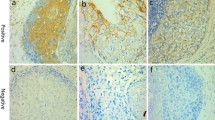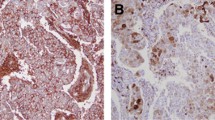Abstract
The hypothesis on cancer stem cells assumes the existence of small subpopulation of cells that possess the ability to undergo self-renewal and can give rise to the diversity of differentiated cells that form the tumour. It has been accepted that CD44+/CD24−/low phenotype is one of the features characterizing breast cancer stem cells. The aim of our study was to assess (1) prognostic significance of CD44/CD24 expression as well as (2) a relation between the above-mentioned phenotype and breast cancer subtypes [based on estrogen (ER), progesterone receptors, human epidermal growth factor receptor 2 and Ki67 status] and expression of selected markers such as fascin, laminin-5 gamma-2 chain, cytokeratin (CK) 5/6 and 8/18, epidermal growth factor receptor (EGFR), smooth muscle actin, P-cadherin and lymphocytic infiltration in invasive ductal breast cancer patients (T ≥ 1, N ≥ 1, M0), who underwent mastectomy followed by chemotherapy (with taxanes and/or anthracyclines) or/and hormonotherapy. We noted that most cancers with CD44−/CD24− and CD44−/CD24+ phenotype were ER positive. The majority of CD44−/CD24−, CD44−/CD24+ and CD44+/CD24− tumours were characterized by CK5/6 and EGFR negativity. In univariate analysis we demonstrated that patients with pN1/pN2 and with CD44 +/CD24- carcinomas had significantly lower risk of progression or cancer-related death than those with pN3 or tumours characterised by other CD44/CD24 expression patterns. We also found 100 % DFS in 12 patients with CD44+/CD24−/CK5/6+/ER− phenotype. Other analysed parameters were insignificant. We conclude that tumours with immunophenotypes: CD44+/CD24− and CD44+/CD24−/CK5/6+/ER− might be more sensitive for chemotherapy based on taxanes and/or anthracyclines.


Similar content being viewed by others
References
Abraham BK, Fritz P, McClellan M, Hauptvogel P, Athelogou M, Brauch H (2005) Prevalence of CD44+/CD24−/low cells in breast cancer may not be associated with clinical outcome but may favor distant metastasis. Clin Cancer Res 11(3):1154–1159
Ailles LE, Weissman IL (2007) Cancer stem cells in solid tumors. Curr Opin Biotechnol 18(5):460–466
Al-Alwan M, Olabi S, Ghebeh H et al (2011) Fascin is a key regulator of breast cancer invasion that acts via the modification of metastasis-associated molecules. PLoS ONE 6(11):e27339
Al-Hajj M, Wicha MS, Benito-Hernandez A, Morrison SJ, Clarke MF (2003) Prospective identification of tumorigenic breast cancer cells. Proc Natl Acad Sci USA 100(7):3983–3988
Anders CK, Carey LA (2009) Biology, metastatic patterns, and treatment of patients with triple-negative breast cancer. Clin Breast Cancer 9(Suppl 2):S73–S81
Athanassiadou P, Grapsa D, Gonidi M, Athanassiadou AM, Tsipis A, Patsouris E (2009) CD24 expression has a prognostic impact in breast carcinoma. Pathol Res Pract 205(8):524–533
Badve S, Nakshatri H (2012) Breast-cancer stem cells-beyond semantics. Lancet Oncol 13(1):e43–e48
Bocker W, Moll R, Poremba C et al (2002) Common adult stem cells in the human breast give rise to glandular and myoepithelial cell lineages: a new cell biological concept. Lab Invest 82(6):737–746
Catusse C, Polette M, Coraux C, Burlet H, Birembaut P (2000) Modified basement membrane composition during bronchopulmonary tumor progression. J Histochem Cytochem 48(5):663–669
Deng J, Gao G, Wang L, Wang T, Yu J, Zhao Z (2012) CD24 expression as a marker for predicting clinical outcome in human gliomas. J Biomed Biotechnol 517172, doi:10.1155/2012/517172
Dontu G, El-Ashry D, Wicha MS (2004) Breast cancer, stem/progenitor cells and the estrogen receptor. Trends Endocrinol Metab 15(5):193–197
Fountzilas G, Dafni U, Bobos M et al (2012) Differential response of immunohistochemically defined breast cancer subtypes to anthracycline-based adjuvant chemotherapy with or without paclitaxel. PLoS ONE 7(6):e37946
Goldhirsch A, Wood WC, Gelber RD et al (2007) Progress and promise: highlights of the international expert consensus on the primary therapy of early breast cancer. Ann Oncol 18(7):1133–1144
Goldhirsch A, Wood WC, Coates AS et al (2011) Strategies for subtypes–dealing with the diversity of breast cancer: highlights of the St. Gallen International Expert Consensus on the Primary Therapy of Early Breast Cancer 2011. Ann Oncol 22(8):1736–1747
Grothey A, Hashizume R, Sahin AA, McCrea PD (2000) Fascin, an actin-bundling protein associated with cell motility, is upregulated in hormone receptor negative breast cancer. Br J Cancer 83(7):870–873
Harris LN, Broadwater G, Lin NU, et al. (2006) Molecular subtypes of breast cancer in relation to paclitaxel response and outcomes in women with metastatic disease: results from CALGB 9342. Breast Cancer Res 8(6):R66
Honeth G, Bendahl PO, Ringnér M et al (2008) The CD44 +/CD24- phenotype is enriched in basal-like breast tumors. Breast Cancer Res 10(3):R53
Horiguchi K, Toi M, Horiguchi S et al (2010) Predictive value of CD24 and CD44 for neoadjuvant chemotherapy response and prognosis in primary breast cancer patients. J Med Dent Sci 57(2):165–175
Hugh J, Hanson J, Cheang MC, Nielsen TO, Perou CM, Dumontet C, Reed J, Krajewska M, Treilleux I, Rupin M, Magherini E, Mackey J, Martin M, Vogel C (2009) Breast cancer subtypes and response to docetaxel in node-positive breast cancer: use of an immunohistochemical definition in the BCIRG 001 trial. J Clin Oncol 27(8):1168–1176
Idowu MO, Kmieciak M, Dumur C et al (2012) CD44(+)/CD24(-/low) cancer stem/progenitor cells are more abundant in triple-negative invasive breast carcinoma phenotype and are associated with poor outcome. Hum Pathol 43(3):364–373
Jaggupilli A, Elkord E (2012) Significance of CD44 and CD24 as cancer stem cell markers: an enduring ambiguity. Clin Dev Immunol doi: 10.1155/2012/708036
Jia Z, Zhao W, Fan L, Sheng W (2012) The expression of PCNA, c-erbB-2, p53, ER and PR as well as atypical hyperplasia in tissues nearby the breast cancer. J Mol Histol 43(1):115–120
Kim HJ, Kim MJ, Ahn SH et al (2011) Different prognostic significance of CD24 and CD44 expression in breast cancer according to hormone receptor status. Breast 20(1):78–85
Konecny GE, Pauletti G, Untch M et al (2010) Association between HER2, TOP2A, and response to anthracycline-based preoperative chemotherapy in high-risk primary breast cancer. Breast Cancer Res Treat 120(2):481–489
Kristiansen G, Sammar M, Altevogt P (2004) Tumour biological aspects of CD24, a mucin-like adhesion molecule. J Mol Histol 35(3):255–262
Kwon GY, Ha H, Ahn G, Park SY, Huh SJ, Park W (2007) Role of CD24 protein in predicting metastatic potential of uterine cervical squamous cell carcinoma in patients treated with radiotherapy. Int J Radiat Oncol Biol Phys 69(4):1150–1156
Lim SC (2005) CD24 and human carcinoma: tumor biological aspects. Biomed Pharmacother 59(Suppl 2):S351–S354
Lim SC, Oh SH (2005) The role of CD24 in various human epithelial neoplasias. Pathol Res Pract 201(7):479–486
Nielsen TO, Hsu FD, Jensen K et al (2004) Immunohistochemical and clinical characterization of the basal-like subtype of invasive breast carcinoma. Clin Cancer Res 10:5367–5374
Niemiec J, Adamczyk A, Małecki K, Ambicka A, Ryś J (2013) Tumor grade and matrix metalloproteinase 2 expression in stromal fibroblasts help to stratify the high-risk group of patients with early breast cancer identified on the basis of St Gallen recommendations. Clin Breast Cancer 13(2):119–128
Oliveira LR, Jeffrey SS, Ribeiro-Silva A (2010) Stem cells in human breast cancer. Histol Histopathol 25(3):371–385
Paredes J, Lopes N, Milanezi F et al (2007) P-cadherin and cytokeratin 5: useful adjunct markers to distinguish basal-like ductal carcinomas in situ. Virchows Arch 450:73–80
Park SY, Lee HE, Li H, Shipitsin M, Gelman R, Polyak K (2010) Heterogeneity for stem cell-related markers according to tumor subtype and histologic stage in breast cancer. Clin Cancer Res 16(3):876–887
Rakha EA, Putti TC, Abd El-Rehim DM et al (2006) Morphological and immunophenotypic analysis of breast carcinomas with basal and myoepithelial differentiation. J Pathol 208(4):495–506
Ricardo S, Vieira AF, Gerhard R et al (2011) Breast cancer stem cell markers CD44, CD24 and ALDH1: expression distribution within intrinsic molecular subtype. J Clin Pathol 64(11):937–946
Rodríguez-Pinilla SM, Sarrió D, Honrado E, Hardisson D, Calero F, Benitez J, Palacios J (2006) Prognostic significance of basal-like phenotype and fascin expression in node-negative invasive breast carcinomas. Clin Cancer Res 12(5):1533–1539
Rouzier R, Perou CM, Symmans WF et al (2005) Breast cancer molecular subtypes respond differently to preoperative chemotherapy. Clin Cancer Res 11(16):5678–5685
Skyldberg B, Salo S, Eriksson E et al (1999) Laminin-5 as a marker of invasiveness in cervical lesions. J Natl Cancer Inst 91(21):1882–1887
Sorlie T, Tibshirani R, Parker J et al (2003) Repeated observation of breast tumor subtypes in independent gene expression data sets. Proc Natl Acad Sci USA 100(14):8418–8423
Sung JY, Kim GY, Park YK, Lee J, Kim YW, Lim SJ (2010) Clinicopathological significance of invasive ductal carcinoma with high prevalence of CD44+/CD24−/low tumor cells in breast cancer. Korean J Pathol 44(4):390–396
Surowiak P, Materna V, Györffy B et al (2006) Multivariate analysis of oestrogen receptor alpha, pS2, metallothionein and CD24 expression in invasive breast cancers. Br J Cancer 95(3):339–346
Tanei T, Morimoto K, Shimazu K et al (2009) Association of breast cancer stem cells identified by aldehyde dehydrogenase 1 expression with resistance to sequential Paclitaxel and epirubicin-based chemotherapy for breast cancers. Clin Cancer Res 15(12):4234–4241
Thike AA, Iqbal J, Cheok PY et al (2010) Triple negative breast cancer: outcome correlation with immunohistochemical detection of basal markers. Am J Surg Pathol 34(7):956–964
Tischkowitz M, Brunet JS, Be′gin LR et al (2007) Use of immunohistochemical markers can refine prognosis in triple negative breast cancer. BMC Cancer 7:134–145
Wang Z, Shi Q, Wang Z et al (2011) Clinicopathologic correlation of cancer stem cell markers CD44, CD24, VEGF and HIF-1α in ductal carcinoma in situ and invasive ductal carcinoma of breast: an immunohistochemistry-based pilot study. Pathol Res Pract 207(8):505–513
Wolff AC, Hammond ME, Schwartz JN et al (2007) American Society of Clinical Oncology/College of American Pathologists guideline recommendations for human epidermal growth factor receptor 2 testing in breast cancer. J Clin Oncol 25(1):118–145
Yoder BJ, Tso E, Skacel M et al (2005) The expression of fascin, an actin-bundling motility protein, correlates with hormone receptor-negative breast cancer and a more aggressive clinical course. Clin Cancer Res 11(1):186–192
Acknowledgments
The study was supported by the Polish Ministry of Science and Higher Education; grant number NN401 096137.
Author information
Authors and Affiliations
Corresponding author
Rights and permissions
About this article
Cite this article
Adamczyk, A., Niemiec, J.A., Ambicka, A. et al. CD44/CD24 as potential prognostic markers in node-positive invasive ductal breast cancer patients treated with adjuvant chemotherapy. J Mol Hist 45, 35–45 (2014). https://doi.org/10.1007/s10735-013-9523-6
Received:
Accepted:
Published:
Issue Date:
DOI: https://doi.org/10.1007/s10735-013-9523-6




